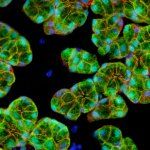Two Projects Using Hydrogel Biomaterials to Stimulate Tissue Regeneration Move Forward with New Funding

Two innovative UCSF projects in hydrogel therapies to develop new salivary glands and restore muscle loss after facial injuries have received critical funding to move closer to clinical trials.
If the therapies continue to show promise, the projects will transition to receive funding through a five-year, $30 million continuation grant from the National Institute of Dental and Craniofacial Research (NIDCR) to fund a California consortium’s efforts to expand regenerative therapies for craniofacial and dental defects, which affect millions of Americans. The new grant, of which $11.6 million was awarded to UCSF, will help advance the consortium’s initial projects to the point of clinical trials for new products or procedures.
A consortium of six California academic institutions, the Center for Dental, Oral and Craniofacial Tissue and Organ Regeneration (C-DOCTOR) is co-led by UCSF and the University of Southern California, with UC Berkeley, UC Davis, UCLA and Stanford University. It serves as a comprehensive public-private national resource center to translate innovative regenerative research into clinical therapies to replace dental, oral and craniofacial tissues or organs lost to congenital disorders, trauma, disease and medical procedures.
Of the original 17 teams that C-DOCTOR has supported, nine projects have continued, including two with UCSF faculty, both members of the Eli & Edythe Broad Center for Regeneration Medicine and Stem Cell Research:
- An injectable hydrogel project led by Sarah Knox, PhD, associate professor in the School of Dentistry, aims to activate stem-cell-mediated regeneration of the salivary gland. The product, which is in early animal trials, could provide the first viable long-term treatment for Sjogren’s syndrome or for other patients suffering from dry mouth (xerostomia) after undergoing head and/or neck radiation therapy.
- A collaboration led by UC Berkeley – with Jason Pomerantz, MD, a UCSF associate professor of surgery, and researchers at the University of Virginia – is developing a novel bioinspired hydrogel to assist with muscle regeneration in more severe cranio-maxillary-fascial injuries. The product also is in early animal trials, with a U.S. Food and Drug Administration (FDA) meeting expected in late 2020.
Craniofacial and dental defects have devastating effects on patients, due to the vital sensory organs and brain that are housed within the cranium, the importance of the mouth and teeth in overall health, and the significance of the face in personal identity. In recent years, new biomaterials have shown promise as bio-inspired solutions to these problems.
“We are excited to advance our technology teams toward human clinical trials,” said Jeffrey Lotz, PhD, professor and vice chair of research and the David S. Bradford, MD, Endowed Chair of Orthopaedic Surgery at UCSF. “In doing so, we will continue to refine a model to identify promising research discoveries that align with unmet clinical needs, while at the same time addressing a valuable commercial market that will attract the investments needed to bring regenerative therapies to patients.”
The initiative was launched in 2016, when NIDCR provided planning grants to 10 groups to assemble comprehensive teams to support researchers, expedite technologies and therapeutics for FDA clinical trials, and guide commercialization strategies for new therapies. Three groups – UCSF, UC Berkeley, UC Davis; UCLA, Stanford; and USC – combined resources to form the C-DOCTOR consortium, which received a $12 million start-up grant in 2017.